Tribhuvan International Airport
Tribhuvan International Airport (Nepali: त्रिभुवन अन्तर्राष्ट्रिय विमानस्थल) (IATA: KTM, ICAO: VNKT, colloquially referred to as TIA) is an international airport located in Kathmandu, Bagmati Pradesh, Nepal. The airport is named after Tribhuvan Bir Bikram Shah, former King of Nepal and is the only international airport in Nepal, operating with a tabletop runway, one domestic and an international terminal. It connects Nepal to more than 40 destinations in 17 countries.
Tribhuvan International Airport त्रिभुवन अन्तर्राष्ट्रिय विमानस्थल | |||||||||||
|---|---|---|---|---|---|---|---|---|---|---|---|
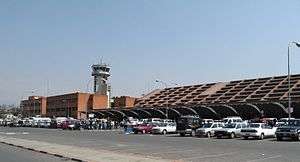 | |||||||||||
| Summary | |||||||||||
| Airport type | Public | ||||||||||
| Owner | Government Of Nepal | ||||||||||
| Operator | Civil Aviation Authority of Nepal (CAAN) | ||||||||||
| Serves | Kathmandu, Nepal | ||||||||||
| Hub for | |||||||||||
| Elevation AMSL | 4,390 ft / 1,338 m | ||||||||||
| Coordinates | 27°41′47″N 085°21′32″E | ||||||||||
| Website | www.tiairport.com.np | ||||||||||
| Map | |||||||||||
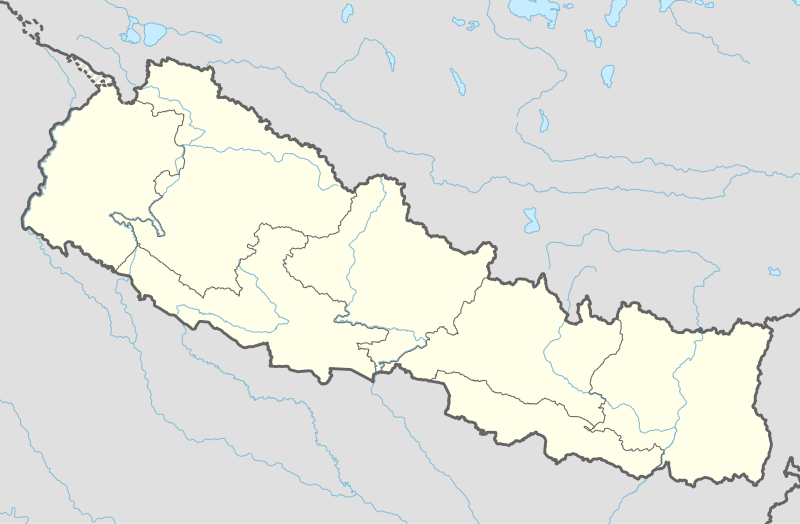 KTM Location within Nepal | |||||||||||
| Runways | |||||||||||
| |||||||||||
| Statistics (2019) | |||||||||||
| |||||||||||
The airport is a hub for two international airlines, the flag carrier Nepal Airlines and Himalaya Airlines, along with several other Nepalese airlines. Seasonally, Buddha Air also offers scheduled international flights to nearby Indian cities. The airport is considered as a starting point to Mount Everest, with several daily flights to Lukla. A few airlines also offer Everest sightseeing flights out of Kathmandu.
Due to severe traffic congestion and the airport running out of its maximum capacity, the Government of Nepal has initiated the construction of additional international airports, notably, Nijgadh International Airport, Pokhara International Airport and Gautam Buddha Airport.
History
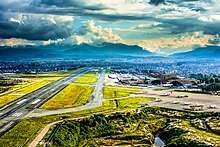
The airport was originally named Gauchaur Airport, after the area of Kathmandu where it was situated. In Nepali, 'Gauchaur' refers to a place where cows graze. The formal beginning of aviation in Nepal occurred in 1949, with the landing of a Beechcraft Bonanza carrying the Indian ambassador. The first charter flight took place between Gauchaur and Calcutta, in a Himalayan Aviation Dakota on 20 February 1950.[4]
On 20 February 1949, an Indian registered Dakota DC-3 commenced the first ever scheduled service, linking Kathmandu to Patna, Kolkata and Delhi.[5]
In 1950, King Tribhuvan took refuge at the Indian embassy in an attempt to overthrow the Rana dynasty. Gyanendra Bir Bikram Shah, the four-year-old grandson of Tribhuvan was crowned the new king. On 10 November 1950, two Indian planes landed at Gauchaur Airport and carried the young king along with his grandfather to Delhi. After the Delhi Accord, the Rana regime ended and King Tribhuvan landed at Gauchaur Airport as the monarch on 18 February 1951, bringing the waves of democracy in Nepal.[5]
In 1952, the first scheduled domestic flights commenced to Bhairahawa, Biratnagar, Pokhara and Simara.[5]
On 15 June 1955, the airport was inaugurated by King Mahendra and renamed Tribhuvan Airport in memory of the king's father. The airport was again renamed to Tribhuvan International Airport in 1964.[5]
In 1957, the original 3,700 feet (1,100 m) grass runway 16/34 was re-laid in concrete. In 1964, runway 16/34 was abandoned for a newer 6,600 feet (2,000 m) runway 02/20. The new runway was extended from 6,600 feet (2,000 m) to 10,000 feet (3,000 m) with the joint effort of the Asian Development Bank (ADB) and the OPEC in 1975.[4] The runway was re-strengthened in 1981.[5]
In 1961, Queen Elizabeth II landed in a Dakota plane for her first visit to Nepal, one of the most high profile arrival at the airport.[6]
In 1967, Tribhuvan International Airport witnessed its first jet aircraft, a Lufthansa Boeing 707[4] and 1972, the Nepali flag carrier, Royal Nepal Airlines commenced jet operations from the airport with a Boeing 727.[4] The same year, Nepali personnel took over air traffic services from the Indian personnel.[5]
In 1985, the extension apron of the runway 02/20 was overlaid. Similarly, the development of the terminal building was commenced in the same year. In 1987, the construction of the Airlines Operation and Control Tower building was completed and the taxiway was overlaid. In the same year, on 11 October, Nepal witnessed the first ever landing of Concorde.[7] In 1989, the construction of the terminal building was completed and on 18 February 1990, the newly built TIA complex were officially inaugurated by King Birendra Bir Bikram Shah.[5]
In 1992, Necon Air, Nepal's first private airline commenced the domestic operations from TIA with Hawker Siddeley HS 748.[5]
In 1995, works started to expand the domestic terminal. Likewise, Amplitude modulation signalling system (AMSS) and very-small-aperture terminal (V-SAT) were also installed at the airport.
In 1997, airport surveillance radar (ASR) and secondary surveillance radar (SSR) came into the operation. The installation of radar surveillance was proposed by Japan in 1994, following the crash of Thai Airways Flight 311 and Pakistan International Airlines Flight 688 in 1992, which claimed the lives of 280 people altogether; including the 17 high-level Japanese diplomats. On 9 September 1998, Prime Minister Girija Prasad Koirala officially inaugurated the radars.[5][8]
In May 2007, Austrian Airlines discontinued its flight to Vienna, Nepal's last direct air link to Europe.[9] In September 2013, Turkish Airlines launched direct flights from Istanbul to Kathmandu, re-establishing Nepal's connection with continental Europe.[10]
In August 2013, the airport's only runway had to be closed for wide-body aircraft because the runway, which was in disrepair, could no longer withstand their weight.[11]
In 2020, the runway was extended to 3,350 metres (10,990 ft), the departure hall was expanded to accommodate 1500 more passengers, the arrival area was extended to a lower level and the immigration hall was facelifted.[12][13]
Facilities
Apron
The international apron at TIA can handle up to 15 aircraft, although only three can support wide-body category aircraft. There is also a bay at the eastern side of the airport that can hold two wide-body and two ATR 72 or similar type of aircraft. The eastern bay is used solely to park disabled or non-operational airplanes. Two new international aprons are under-construction to the south of the existing aprons.
The aprons at the domestic terminal have been accommodating up to 35 aircraft, despite its allowable capacity of only 17.[14] The helipad at TIA can handle up to 17 helicopters.
Runway
The airport has a single 3,350 metres (10,990 ft) runway with a slope of 1.2%[15] oriented at 02/20. There is no instrument landing system available.[16] The bitumen runway with the strength of PCN 54F/A/W/T has the markings of the centerline, edge, touchdown zone and the threshold. The runway is equipped with high intensity centerline lights, bidirectional raised edge lights, the threshold lights and the runway end lights. Precision approach path indicator (PAPI) lights (3°) are installed as landing aids for the both runways 02/20. The runway has five intersections with the taxiways. The taxiway G runs parallel to the runway but it doesn't connect the thresholds.[15]
Aids to Navigation
There are two non-precision approach available at the Kathmandu Airport; VHF omnidirectional range along a distance measuring equipment (VOR/DME) and Random Area Navigation (RNAV/RNP). A high intensity 870 metres (2,850 ft) extended centerline lights are installed at the southern end of the airport to assist with the approach.
Terminals
The airport has two public terminals, one for international and one for domestic traffic. A terminal for VIP guests is also operated by the Government of Nepal, where international state guests are welcomed. There are plans to construct a separate terminal for helicopter transportation.[17]
Radisson Hotel Kathmandu operates an executive lounge for first and business class passengers for several airlines[18] and Thai Airways operates a lounge for its business-class passengers, as well as Star Alliance Gold card holders.[19]
Aircraft Maintanance
Nepal Airlines operates a large hangar between the international and domestic terminals. There are plans to upgrade and move this facility to the eastern side of the airside.[20] Buddha Air operates a closed door hangar facility, which can accommodate narrow-body aircraft at the eastern side of the airport.[21]
Location and access
Tribhuvan International Airport is located 1 km (0.6 mi) from Pashupatinath Temple and 6 km (3.7 mi) east of the city center and main tourist area Thamel.[22] The nearest hotel is Airport Hotel located about 200 m (0.1 mi) from the airport gate.[23]
The airport is connected to major parts of Kathmandu valley by the ring road.
Airlines and destinations
Passenger
As a result of the 2019–20 coronavirus pandemic, the Government of Nepal has suspended all domestic and international flights until 30 June 2020.[24]
Several airlines (including Buddha Air, Yeti Airlines and Simrik Airlines) also provide daily mountain sightseeing flights or Mount Everest sightseeing flights out of Kathmandu Airport. They usually depart from the domestic terminal in the early morning hours and return to the airport one hour later.[43][49][50]
The helicopter operators Air Dynasty, Manang Air, Prabhu Helicopter, Simrik Air, Shree Airlines and Fishtail Air offer helicopter operations out of their respective hubs at Tribhuvan International Airport.
Cargo
In 2019, TIA handled a total of 10,572 tons of cargo.
| Airlines | Destinations | Refs. |
|---|---|---|
| Uni-Top Airlines | Kunming |
Statistics
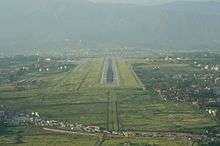

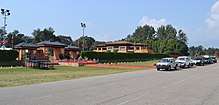
| Year[51][52][53][54] | Passenger Movement | Aircraft Movement |
|---|---|---|
| 2000 | 1,914,349 | 64,103 |
| 2001 | ||
| 2002 | ||
| 2003 | ||
| 2004 | ||
| 2005 | ||
| 2006 | ||
| 2007 | ||
| 2008 | ||
| 2009 | ||
| 2010 | ||
| 2011 | ||
| 2012 | ||
| 2013 | ||
| 2014 | ||
| 2015 | ||
| 2016 | ||
| 2017 | ||
| 2018 | ||
| 2019 |
Airline Market Share
| Rank | Carrier | Number of passengers | Change from previous year |
|---|---|---|---|
| 1 | 735,835 | ||
| 2 | 450,949 | ||
| 3 | 274,668 | ||
| 4 | 237,441 | ||
| 5 | 228,928 |
| Rank | Carrier | Number of passengers | Passenger share |
|---|---|---|---|
| 1 | Buddha Air | 1,325,409 | 46.5% |
| 2 | Yeti Airlines | 668,664 | 23.5% |
| 3 | Shree Airlines | 447,877 | 15.7% |
| 4 | Saurya Airlines | 106,142 | 3.73% |
| 5 | Nepal Airlines | 79,172 | 2.78% |
Future Expansion Plan
According to the CAAN Aviation Report - 2017, Tribhuvan International will undergo expansions under Transport Project Preparatory Facility funded partly by the Asian Development Bank. Major works include:[57]
- Construction of a parallel taxiway system and side strip
- Construction of a new international terminal building
- Reconfiguration of existing international terminal building to domestic terminal building
- Relocation of Nepal Airlines hangar
- Relocation of Nepal Army infrastructure, hangar and other associated work

Ground transportation
Sajha Yatayat buses connect the airport's international terminal to Kathmandu's city centre, and Lalitpur's city centre.[58] Buses from other local companies stop in front of the airport's main gate, 500 meters in front of the terminal buildings.[59] Meter and prepaid taxis are available at both terminals at all hours.[60]
Incidents and accidents
- On 10 May 1973, a Douglas DC-8 operated by Thai Airways overran the runway on landing with 100 of passengers and 10 crew on board, there was one fatality.[61]
- On 31 July 1992, an Airbus A310-304, operating as Thai Airways International Flight 311 crashed into a mountain while approaching Kathmandu, killing all 113 people on board.[62]
- On 28 September 1992, an Airbus A300 B4-203 operating as Pakistan International Airlines Flight 268 crashed while approaching Kathmandu, killing all 167 on board,[63] making it the worst air accident in Nepal.
- On 17 January 1995, a de Havilland Canada DHC-6 Twin Otter operating as Royal Nepal Airlines Flight 133 from Kathmandu to Rumjatar, had problems getting airborne at Tribhuvan International Airport. The aircraft struck the airfield perimeter fence and plunged into fields. Of three crew and 21 passengers on board, one crew member and one passenger were killed.[64]
- On 7 July 1999, a Boeing 727-200F operated by Lufthansa Cargo crashed in the Champadevi hills at the 7550 feet level, five minutes after takeoff, when it should have been at an altitude of 9500 feet. All five crew members on board were killed.[65]
- On 5 September 1999, a BAe 748-501 Super 2B operating as Necon Air Flight 128 from Pokhara to Kathmandu, crashed while approaching Tribhuvan International Airport. The aircraft collided with a communication tower of Nepal Telecommunication Corporation and crashed in a wooded area 25 km west of Kathmandu. All 10 passengers and 5 crew were killed.[66]
- On 26 December 1999, an Airbus A300B2-101 operating as Indian Airlines Flight 814 was hijacked en route from Kathmandu to Delhi. The aircraft ended up in Kandahar, Afghanistan. Indian Airlines suspended all flights to and from Nepal for some time, fearing a lack of security at check-in.[67]
- On 24 December 2008, a de Havilland Canada DHC-6 Twin Otter operated by Nepal Airlines ran off the runway during takeoff[68]
- On 24 August 2010, a Dornier Do 228 operating as Agni Air Flight 101 crashed into hills outside Kathmandu in heavy rain.[69] All on board (3 crew, 11 passengers) were killed.[70] The plane, crashed near Shikharpur village, 80 km (50 mi) south of Kathmandu. The aircraft had left Tribhuvan International Airport, bound for Tenzing-Hillary Airport.
- On 25 September 2011, a Beechcraft 1900D operating as Buddha Air Flight 103, struck terrain while approaching Tribhuvan International Airport. There were 16 passengers and three crew members on board. Initial reports stated there was one survivor, who died en route to hospital. At the time of the crash, the weather was overcast with very low clouds and flights were operating under visual flight rules. The aircraft was on the base leg of the approach following a sightseeing flight.[71]
- On 28 September 2012, a Dornier Do 228 operating as Sita Air Flight 601, crashed soon after take-off, after apparently hitting a vulture. Sixteen passengers and three crew members were killed.[72]
- On 4 March 2015, an Airbus A330-300 operated by Turkish Airlines veered off the runway after attempting to land in dense fog. The aircraft had been circling for 30 minutes and was making its second landing attempt, after a previous aborted attempt due to poor visibility.[73] The aircraft skidded into soft grass causing the nose wheel to collapse and the airport to temporarily close to all international flights.[74] All 227 passengers and 11 crew members evacuated the aircraft safely.[75]
- On 12 March 2018, a Bombardier Dash 8 Q400 operating as US-Bangla Airlines Flight 211, carrying 67 passengers and 4 crew veered off the runway while landing then crashed on the east side of Tribhuvan International Airport before catching fire. 47 passengers and 4 crew were killed.[76]
- On 19 April 2018, a Boeing 737-900ER operated by Malindo Air on a scheduled flight to Kuala Lumpur, Malaysia overran the runway after a high-speed rejected takeoff. The aircraft skidded roughly 250 feet (75 meters) south of the runway end and stopped along a grassy area between two runways. All 132 passengers and seven crew members escaped injury. Damage to the aircraft was minor, and the airport was closed for 12 hours until it was removed. The flight crew opted to abort the takeoff due to a warning indicated the aircraft was not correctly configured.[77]
- On 1 September 2018, a BAe Jetstream 41 operated by Yeti Airlines en route from Nepalgunj skidded off the runway, seconds after touching down. All 21 passengers and the crew of 3, evacuated the aircraft safely without injuries but the aircraft was written off. Slippery runway due to rainfall was reported to be the cause of the incident.[78]
- On 12 July 2019, an ATR 72-500 operated by Yeti Airlines coming from Nepalgunj skidded off the runway just as it landed at Tribhuvan International Airport. There were 68 people onboard including 4 crew members, all of them evacuated the aircraft safely but two of the passengers received minor injuries.[79]
See also
References
- "Tribhuvan International Airport". Civil Aviation Authority of Nepal. Archived from the original on 28 September 2007.
- Airport information for VNKT at World Aero Data. Data current as of October 2006.Source: DAFIF.
- Airport information for KTM / VNKT at Great Circle Mapper. Source: DAFIF (effective October 2006).
- Administrator. "Chronology". Retrieved 3 January 2015.
- "Tribhuvan International Airport". Tribhuvan International airport. Retrieved 11 April 2020.
- Queen Elizabeth II on a Tiger Shoot in Katmandu (1961) | British Pathé, retrieved 9 June 2020
- "The First Landing of a Concorde in Nepal". YouTube. 28 November 2010.
- "Advanced radar system to make Nepal's skies safer". kathmandupost.com. Retrieved 11 April 2020.
- "Austrian bids farewell to the 737", Airliner World, June 2013: p6
- "New airline routes launched (20 August – 2 September 2013)". anna.aero. 5 September 2013. Retrieved 2 June 2020.
- Mathews, Neelam (2 September 2013). "Cracked Kathmandu Airport Runway Now Restricted". AIN online. Retrieved 2 June 2020.
- Prasain, Sangam (1 June 2020). "Runway end safety areas at Tribhuvan International Airport improved". The Kathmandu Post. Retrieved 2 June 2020.
- Ass. "New, improved TIA". Retrieved 4 June 2020.
- "Poor airport infra to put brakes on fleet expansion". kathmandupost.com. Retrieved 11 April 2020.
- "CAAN Aviation report VNKT" (PDF). Civil Aviation Authority of Nepal.
- "Kathmandu – Tribhuvan Airport (KTM/VNKT)". azworldairports.com. Retrieved 5 March 2015.
- "Separate helicopter terminal to be built at TIA". Aviation Nepal. 20 December 2018. Retrieved 31 January 2019.
- "Airport Restaurant and Executive Lounge" (PDF). Radisson. Retrieved 1 April 2018.
- "Royal Orchid Lounge". Thai Airways. Retrieved 1 April 2018.
- "India to help Nepal build new hangars at the Kathmandu airport". The Economic Times. 14 September 2018. Retrieved 1 May 2019.
- "Hangar Profile" (PDF). Archived from the original (PDF) on 22 January 2015. Retrieved 1 May 2019.
- "Tribhuvan International Airport". gettocenter.com. Retrieved 31 January 2017.
- "About | Airport Hotel". Retrieved 9 June 2020.
- "Nepal extends International flight suspension until June 30". Aviation Nepal. Retrieved 31 May 2020.
- "Air India Flight Schedule". Air India. Retrieved 8 November 2018.
- "#HappyAlert". Buddha Air. Retrieved 20 December 2019.
- "Himalaya Airlines plans Beijing Daxing launch in late October 2019". Routes Online. Retrieved 22 September 2019.
- Liu, Jim. "Himalaya Airlines W19 network adjustment as of 08NOV19". Routesonline. Retrieved 13 November 2019.
- "Himalaya Airlines resumes Chongqing service in late-Jan 2020". RoutesOnline. Retrieved 9 January 2020.
- "IndiGo to commence Mumbai-Kathmandu service in Jun-2020". CAPA. Retrieved 6 February 2020.
- "Flight Schedule for Domestic & International Flights". IndiGo. Retrieved 25 December 2018.
- "Jazeera Airways adds new destinations in Nov 2019". Routes Online. Retrieved 4 November 2019.
- "Nepal Airlines adds Guangzhou flights from March 2020". Routes Online. Retrieved 3 January 2020.
- "Domestic airline companies issue travel alert for passengers". The Himalayan Times. Retrieved 1 April 2019.
- "Nepal Airlines adds Tokyo service from March 2020". Routes Online. Retrieved 3 January 2020.
- "DOMESTIC SUMMER SCHEDULE". Nepal Airlines. Retrieved 1 July 2019.
- "International Flight Schedule". Nepal Airlines. Retrieved 9 October 2018.
- "Revised International Schedule wef 01 April till 30 June 2019". Nepal Airlines. Retrieved 14 March 2019.
- "Shree Airlines commencing flight to Janakpur from tomorrow".
- "Rajbiraj Airport to resume its flight services from May 8 as Shree Airline prepares for flight operation". Aviation Nepal. Retrieved 24 April 2019.
- "Shree Airlines - Fly the new High". Shree Airlines. Retrieved 1 May 2018.
- "Shree Airlines preparing Rajbiraj flights starting from June 24". Aviation Nepal. Retrieved 19 June 2018.
- "Flight Schedule". Simrik Airlines. Retrieved 1 June 2018.
- "Flight Schedule". Sita Air. Retrieved 1 May 2018.
- "Flight Schedule". Summit Air. Archived from the original on 8 July 2017. Retrieved 15 October 2017.
- "Flight Schedule". Tara Air. Retrieved 20 December 2017.
- "Vistara announces flights to Kathmandu from February 11". The Economic Times. 14 January 2020. Retrieved 14 January 2020.
- "Scheduled Flights". Yeti Airlines Pvt. Ltd. Retrieved 31 January 2019.
- "Everest Experience". Buddha Air. Retrieved 15 October 2017.
- "Amazing Everest Experience". Yeti Airlines. Retrieved 15 October 2017.
- "Civil Aviation Report 2009-2010" (PDF). Civil Aviation Authority of Nepal. Retrieved 1 June 2018.
- "Civil Aviation Report 2011-2012" (PDF). Civil Aviation Authority of Nepal. Retrieved 1 June 2018.
- "Civil Aviation Report 2017" (PDF). Civil Aviation Authority of Nepal. Archived from the original (PDF) on 18 June 2018. Retrieved 1 June 2018.
- "Civil Aviation Report Annual 2018" (PDF). Civil Aviation Authority of Nepal. Retrieved 1 June 2019.
- Prasain, Sangam (31 January 2020). "Passenger flow at Kathmandu airport down for the first time in four years". Kantipur Media Group. The Kathmandu Post. Retrieved 1 February 2020.
- "Buddha air tops domestic flights count". Aviation Nepal. 26 February 2019. Retrieved 1 April 2019.
- "Kathmandu Airport is reviewing its master plan as final expansion cost expected to touch $1 billion". The Kathmandu Post. Retrieved 9 June 2020.
- "Kathmandu Valley Route" (in Nepali). Sajha Yatayat. Retrieved 2 June 2020.
- "Kathmandu Airport Guide". Sleeping in Airports. Retrieved 2 June 2020.
- "IN TRANSIT: KATHMANDU'S TRIBHUVAN INTERNATIONAL AIRPORT". Roads & Kingdome. 19 July 2018. Retrieved 1 March 2020.
- Harro Ranter (10 May 1973). "ASN Aircraft accident Douglas DC-8-33 HS-TGU Kathmandu-Tribhuvan Airport (KTM)". Retrieved 9 May 2015.
- "Accident description". Aviation Safety Network. Retrieved 4 February 2017.
- "Hunt goes on for black box in Airbus wreckage". The Independent. Retrieved 4 February 2017.
- Aviation Safety Network. Retrieved 18 November 2006.
- Harro Ranter (7 July 1999). "ASN Aircraft accident Boeing 727-243F VT-LCI Kathmandu". Retrieved 9 May 2015.
- Aviation Safety Network. Retrieved 18 November 2006.
- "Terror on Indian Airlines Flight 814". The Herald. Retrieved 1 February 2017.
- The Aviation Herald. Retrieved 26 December 2008.
- "Nepal tourist plane crash kills 14". BBC News. 24 August 2010.
- "All 14 killed in Nepal plane crash". The Times of India. 24 August 2010. Archived from the original on 27 August 2010.
- "No survivors in Nepal air crash". Aljazeera. Retrieved 4 February 2017.
- Sanjaya Dhakal BBC Nepali (28 September 2012). "BBC News – Nepal plane crash kills 19 at Kathmandu". Bbc.co.uk. Retrieved 20 May 2013.
- Saul, Heather (4 March 2015). "Turkish Airlines flight TK 726 crash-lands on Nepal runway in dense fog". The Independent. Retrieved 5 March 2015.
- "TIA to remain closed until 10 am Friday". eKantipur.com. 5 March 2015. Retrieved 5 March 2015.
- Pokharel, Krishna (4 March 2015). "Turkish Airlines Jet Veers Off Runway in Nepal". The Wall Street Journal. Retrieved 4 March 2015.
- "ASN Aircraft accident de Havilland Canada DHC-8-402Q Dash 8 S2-AGU Kathmandu-Tribhuvan Airport (KTM)". aviation-safety.net.
- "Incident: Batik Malaysia B739 at Kathmandu on Apr 19th 2018, rejected takeoff due to takeoff config warning results in overrun". Avherald.com. Retrieved 15 May 2018.
- "Yeti Airlines Jetstream 41 encounters runway excursion at TIA, all passengers safe". Aviation Nepal. Retrieved 27 September 2018.
- "Yeti Airlines aircraft skids off runway". The Himalayan Times. Retrieved 12 July 2019.
External links
![]()